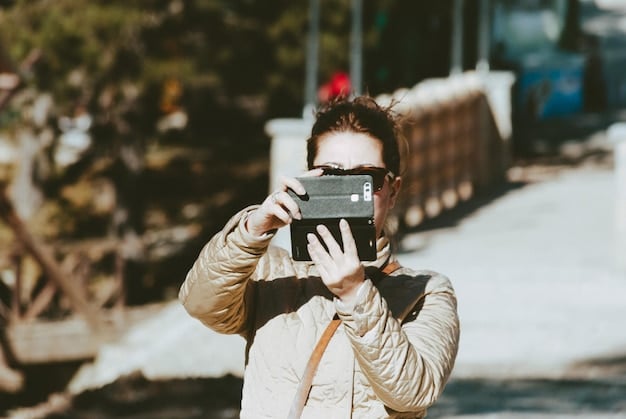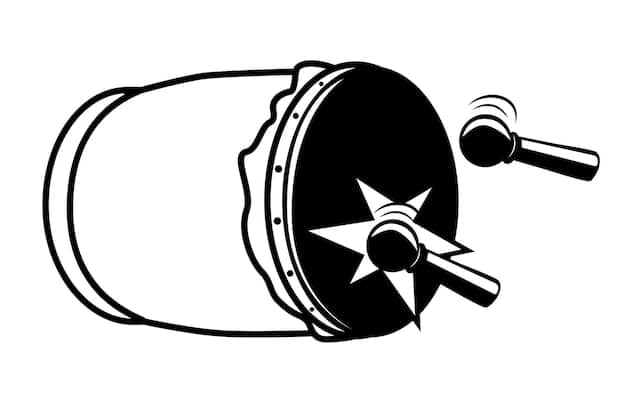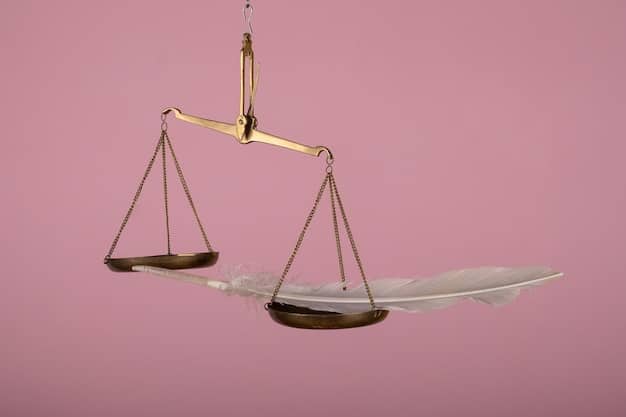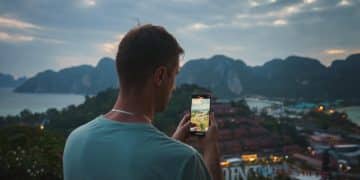Copyright Laws: A US Guide for Travel Bloggers

Understanding copyright laws is crucial for US travel bloggers to protect their original content, including photos, text, and videos, from unauthorized use and ensure legal compliance.
Navigating the legal landscape can be daunting, but for travel bloggers in the US, understanding copyright laws is essential to safeguard your creative work and avoid potential legal pitfalls.
Understanding US Copyright Law Basics
Copyright law in the United States protects original works of authorship, including literary, dramatic, musical, and certain other intellectual works. This protection is automatically granted the moment your content is created and fixed in a tangible medium, such as a blog post or photograph.
This means as a travel blogger, your blog posts, photos, videos, and even your website design are all potentially protected by copyright. It’s important to understand the scope of this protection to effectively manage and defend your creative output.
What Does Copyright Protect?
Copyright law covers a wide range of creative works. Knowing what’s protected can help you understand your rights and avoid infringement.
- Original Text: Your blog posts, articles, and written content.
- Photographs: Images you capture and use on your blog.
- Videos: Travel vlogs, promotional material, and other video content.
- Website Design: The unique layout and design of your travel blog.
Copyright vs. Trademark vs. Patent
It’s easy to confuse copyright with other forms of intellectual property law. Here’s a quick breakdown:
- Copyright: Protects original works of authorship, as mentioned above.
- Trademark: Protects brand names, logos, and other identifiers used to distinguish goods or services.
- Patent: Protects inventions and discoveries.

Understanding these distinctions is important for protecting your overall brand and intellectual property. Know your rights!
Licensing Your Content: Creative Commons and More
As a travel blogger, you might want to allow others to use your content in certain ways. Licensing allows you to grant specific permissions while retaining ownership of your copyright.
One popular licensing option is Creative Commons, which offers various licenses that allow for different levels of use, from attribution-only to non-commercial use.
Understanding Creative Commons Licenses
Creative Commons (CC) licenses provide a flexible way to allow others to use your work while still retaining copyright. There are several types of CC licenses, each with different conditions:
- CC BY (Attribution): Allows others to use your work as long as they give you credit.
- CC BY-SA (Attribution-ShareAlike): Requires that anyone who remixes, transforms, or builds upon your work distribute the resulting work under the same license.
- CC BY-NC (Attribution-NonCommercial): Allows others to use your work for non-commercial purposes only.
- CC BY-ND (Attribution-NoDerivatives): Allows others to use your work as is, without modification.
Creating Your Own License
If Creative Commons doesn’t fit your needs, you can create your own custom license. This allows you to specify exactly how others can use your content.
Consulting with a legal professional is advisable to ensure your custom license is enforceable and meets your specific needs.
Licensing your content gives you control over how it’s used and can open up opportunities for collaboration and promotion.
Fair Use: When Can You Use Copyrighted Material?
Fair use is a legal doctrine that allows you to use copyrighted material without permission in certain circumstances. This can be a complex area of law, so it’s important to understand the limitations.
Generally, fair use is permitted for purposes such as criticism, commentary, news reporting, teaching, scholarship, and research. However, the application of fair use depends on several factors.
The Four Factors of Fair Use
US courts consider four factors when determining whether a particular use qualifies as fair use:
- The purpose and character of the use: Is it for commercial or non-profit educational purposes? Is it transformative, meaning it adds new expression or meaning to the original?
- The nature of the copyrighted work: Is the work factual or creative? Is it published or unpublished?
- The amount and substantiality of the portion used: How much of the original work was used? Was it the “heart” of the work?
- The effect of the use upon the potential market: Does the use harm the potential market for or value of the copyrighted work?
Examples of Fair Use in Travel Blogging
Here are a few examples of how fair use might apply to travel blogging:
- Reviewing a Hotel: Using a photo from the hotel’s website to illustrate your review.
- Commenting on a News Article: Quoting excerpts from a news article about a travel destination.
- Educational Content: Using a short clip from a travel documentary to illustrate a point in your blog post.

Copyright laws are complex and fair use has several nuances. Always give credit to the creator of the original content.
Protecting Your Content: Practical Steps for Travel Bloggers
There are several practical steps you can take to protect your content from copyright infringement. These measures can help deter unauthorized use and make it easier to enforce your rights if infringement occurs.
These steps include registering your content with the US Copyright Office and implementing watermarks to protect your photos.
Watermarking Your Images
Watermarking your images is a simple but effective way to deter unauthorized use. A watermark is a visible or invisible overlay on your image that identifies you as the copyright owner. Here are a few tips for watermarking:
- Use a subtle watermark: Avoid watermarks that are too distracting or cover up important parts of the image.
- Place the watermark in a consistent location: This makes it easier for users to identify your images.
- Use a watermark that includes your name or logo: This helps promote your brand.
Registering Your Copyright
Registering your copyright with the US Copyright Office provides significant legal advantages if you need to enforce your rights in court. Registration allows you to sue for infringement and recover statutory damages and attorney’s fees.
You can register your copyright online through the Copyright Office’s website. It is recommended to register your copyrighted work as soon as possible.
Following these practical steps can significantly reduce the risk of copyright infringement and protect your creative work.
Dealing with Copyright Infringement: What to Do When Someone Steals Your Content
Despite your best efforts, you may still encounter copyright infringement. Knowing how to respond can help you protect your rights and get the infringing content removed.
Taking swift action after the copyright has been infringed protects your content.
Sending a DMCA Takedown Notice
The Digital Millennium Copyright Act (DMCA) provides a legal framework for removing infringing content from online platforms. If you find your content being used without permission, you can send a DMCA takedown notice to the website or hosting provider where the content is located.
Legal Action
If a DMCA takedown notice is not effective, or if the infringement is particularly egregious, you may need to consider legal action. This could involve filing a lawsuit for copyright infringement.
- Consult an Attorney: A copyright attorney can advise you on your legal options and help you navigate the litigation process.
- Gather Evidence: Collect evidence of the infringement, such as screenshots, URLs, and dates of publication.
- Assess Damages: Determine the extent of the damages caused by the infringement, such as lost revenue or reputational harm.
Dealing with copyright infringement can be frustrating, but taking prompt and decisive action is essential to protecting your rights. Legal action can also potentially serve as deterrence for future infringements on your copyright.
Best Practices for Avoiding Copyright Issues as a Travel Blogger
Avoiding copyright issues is always better than dealing with them after the fact. By following best practices, you can minimize the risk of infringement and ensure that your content is legally compliant.
Always be professional regarding copyright and only use work that you have gotten expressed permission to use, or is otherwise free to use.
Obtain Permission
If you want to use someone else’s copyrighted material, the best approach is to obtain permission from the copyright owner. This could involve contacting the owner directly or obtaining a license through a licensing agency.
Use Royalty-Free or Public Domain Content
There are many sources of royalty-free or public domain content that you can use without permission. Royalty-free content typically requires you to pay a one-time fee for the right to use the content, while public domain content is free for anyone to use.
- Pexels/Unsplash: Websites that are full of royalty-free images.
- Creative Commons Search: Search platform to find content by specific licenses.
Being proactive about copyright compliance can save you time, money, and legal headaches in the long run.
| Key Point 🔑 | Brief Description |
|---|---|
| ©️ Copyright Protection | Protects original works automatically upon creation. |
| ⚖️ Fair Use | Allows limited use of copyrighted material without permission for purposes like commentary and review. |
| ⚠️ DMCA Takedown | A legal notice to remove infringing content online. |
| 🔑 Licensing | Granting specific permissions for using your content while retaining ownership. |
Frequently Asked Questions (FAQ)
▼
Copyright infringement occurs when someone uses your copyrighted work without your permission, violating your exclusive rights to reproduce, distribute, display, or create derivative works.
▼
You can register your copyright online through the United States Copyright Office website (copyright.gov). The process involves creating an account, filling out an application, and submitting a copy of your work and a fee.
▼
A DMCA takedown notice is a letter sent to a website or internet service provider requesting that they remove content that infringes on your copyright. It is based on the Digital Millennium Copyright Act (DMCA).
▼
Using images from Google Images without permission can lead to copyright infringement. Always check the image’s license and obtain permission if necessary. It is safer to use royalty-free images or public domain content.
▼
Watermarking helps deter unauthorized use by clearly indicating that the image is copyrighted. It also helps promote your brand and makes it easier for users to identify your images.
Conclusion
In the digital age, understanding copyright laws is not just a legal formality but a fundamental requirement for travel bloggers in the US. Protecting your creative content ensures that your hard work and originality are recognized and respected, allowing you to build a sustainable and legally sound blogging career. By taking proactive steps to secure your copyright and staying informed about best practices, you can navigate the complexities of copyright law with confidence and safeguard your valuable content.





